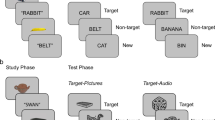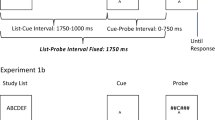Abstract
The study explores the bottom-up attentional consequences of episodic memory retrieval. Individuals studied words (Experiment 1) or pictures (Experiment 2) presented on the left or on the right of the screen. They then viewed studied and new stimuli in the centre of the screen. One-second after the appearance of each stimulus, participants had to respond to a dot presented on the left or on the right of the screen. The dot could follow a stimulus that had been presented, during the study phase, on the same side as the dot (congruent condition), a stimulus that had been presented on the opposite side (incongruent condition), or a new stimulus (neutral condition). Subjects were faster to respond to the dot in the congruent compared to the incongruent condition, with an overall right visual field advantage in Experiment 1. The memory-driven facilitation effect correlated with subjects’ re-experiencing of the encoding context (R responses; Experiment 1), but not with their explicit memory for the side of items’ presentation (source memory; Experiment 2). The results indicate that memory contents are attended automatically and can bias the deployment of attention. The degree to which memory and attention interact appears related to subjective but not objective indicators of memory strength.




Similar content being viewed by others
References
Baddeley AD, Lewis V, Eldridge M, Thomson N (1984) Attention and retrieval from long-term memory. J Exp Psychol Gen 113:518–540
Berlucchi G, Tassinari G, Marzi CA, Di Stefano M (1989) Spatial distribution of the inhibitory effect of peripheral non-informative cues on simple reaction time to non-fixated visual targets. Neuropsychologia 27:201–221
Berryhill ME, Phuong L, Picasso L, Cabeza R, Olson IR (2007) Parietal lobe and episodic memory: bilateral damage causes impaired free recall of autobiographical memory. J Neurosci 27:14415–14423
Cabeza R (2008) Role of parietal regions in episodic memory retrieval: the dual attentional processes hypothesis. Neuropsychologia 46:1813–1827
Cabeza R, Ciaramelli E, Olson IR, Moscovitch M (2008) Parietal cortex and episodic memory: an attentional account. Nat Rev Neurosci 9:613–625
Casarotti M, Michielin M, Zorzi M, Umilta’ C (2007) Temporal order judgment reveals how number magnitude affects visuospatial attention. Cognition 102:101–117
Chun MM, Jiang Y (1998) Contextual cueing: implicit learning and memory of visual context guides spatial attention. Cogn Psychol 36:28–71
Ciaramelli E, Ghetti S, Borsotti M (2008a) Divided attention during retrieval suppresses false recognition in confabulation. Cortex (In press)
Ciaramelli E, Grady CL, Moscovitch M (2008b) Top–down and bottom–up attention to memory: a hypothesis (AtoM) on the role of the posterior parietal cortex in memory retrieval. Neuropsychologia 46:1828–1851
Corbetta M, Shulman GL (2002) Control of goal-directed and stimulus-driven attention in the brain. Nat Rev Neurosci 3:201–215
Craik FIM, Govoni R, Naveh-Benjamin M, Anderson ND (1996) The effects of divided attention on encoding and retrieval processes in human memory. J Exp Psychol Gen 125:474–479
Davidson P, Anaki D, Ciaramelli E, Cohn M, Kim A, Murphy KJ, Troyer AK, Moscovitch M, Levine B (2008) Does lateral parietal cortex support episodic memory retrieval? Evidence from focal-lesion patients. Neuropsychologia 46:1743–1755
di Pellegrino G, Rafal R, Tipper SP (2005) Implicitly evoked actions modulate visual selection: evidence from parietal extinction. Curr Biol 15:1469–1472
Eichenbaum H (2000) Cortical–hippocampal networks for declarative memory. Nat Rev Neurosci 1:41–50
Farah M (1989) Mechanisms of imagery-perception interaction. J Exp Psychol Hum Percept Perform 15:203–211
Fernandes MA, Moscovitch M (2000) Divided attention and memory: evidence of substantial interference effects at retrieval and encoding. J Exp Psychol Gen 129:155–176
Fernandes MA, Moscovitch M (2002) Factors modulating the effect of divided attention during retrieval of words. Mem Cognit 30:731–744
Fischer MH, Castel AD, Dodd MD, Pratt J (2003) Perceiving numbers causes spatial shifts of attention. Nat Neurosci 6:555–556
Galfano G, Rusconi E, Umilta’ C (2006) Number magnitude orients attention, but not against one’s will. Psychon Bull Rev 13:869–874
Gardiner JM (1988) Functional-aspects of recollective experience. Mem Cognit 16:309–318
Hannula DE, Ryan JD, Tranel D, Cohen NJ (2007) Rapid onset relational memory effects are evident in eye movement behavior, but not in hippocampal amnesia. J Cogn Neurosci 19:1690–1705
Hommel B (2002) Responding to object files: automatic integration of spatial information revealed by stimulus–response compatibility effects. Q J Exp Psychol 55A:567–580
Jacoby LL, Woloshyn V, Kelley CM (1989) Becoming famous without being recognized: unconscious influences of memory produced by divided attention. J Exp Psychol Gen 118:115–125
Kane MJ, Engle RW (2000) Working-memory capacity, proactive interference, and divided attention: limits on long-term memory retrieval. J Exp Psychol Learn Mem Cogn 26:336–358
Kinsbourne M (1970) The cerebral basis of lateral asymmetries in attention. Acta Psychol 33:193–201
Kucera H, Francis WN (1967) Computational analysis of present-day American English. Brown University Press, Providence, RI
Moscovitch M (1979) Information processing in the cerebral hemispheres. In: Gazzaniga MS (ed) Handbook of behavioural neurobiology, vol. 2. Neuropsychology. Plenum Press, New York, pp 379–446
Moscovitch M (1986) Afferent and efferent models of visual perceptual asymmetries: empirical and theoretical implications. Neuropsychologia 14:91–114
Moscovitch M (1992) Memory and working-with-memory—a component process model based on modules and central systems. J Cognit Neurosci 4:257–267
Moscovitch M (1994) Cognitive resources and dual-task interference effects at retrieval in normal people: the role of the frontal lobes and medial temporal cortex. Neuropsychology 8:524–534
Moscovitch M, Catlin J (1970) Interhemispheric transmission of information: measurement in normal man. Psychon Sci 18:211–213
Naveh-Benjamin M, Guez J (2000) Effects of divided attention on encoding and retrieval processes: assessment of attentional costs and a componential analysis. J Exp Psychol Learn Mem Cogn 26:1461–1482
Naveh-Benjamin M, Craik FIM, Guez J, Dori H (1998) Effects of divided attention on encoding and retrieval processes in human memory: further support for an asymmetry. J Exp Psychol Learn Mem Cogn 24:1091–1104
Naveh-Benjamin M, Craik FI, Guez J, Kreuger S (2005) Divided attention in younger and older adults: effects of strategy and relatedness on memory performance and secondary task costs. J Exp Psychol Learn Mem Cogn 31:520–537
Norman KA, O’Reilly RC (2003) Modeling hippocampal and neocortical contributions to recognition memory: a complementary-learning-systems approach. Psychol Rev 110:611–646
Park DC, Smith AD, Dudley WN, Lafronza VN (1989) Effects of age and a divided attention task presented during encoding and retrieval on memory. J Exp Psychol Learn Mem Cogn 15:1185–1191
Posner MI (1980) Orienting of attention. Q J Exp Psychol 32:3–25
Richardson DC, Spivey MJ (2000) Representation, space and Hollywood Squares: looking at things that aren’t there anymore. Cognition 76:269–295
Rizzolatti G, Umilta’ C, Berlucchi G (1971) Opposite superiorities of the right and left cerebral hemispheres in discriminative reaction time to physiognomical and alphabetical material. Brain 94:431–442
Rugg MD, Curran T (2007) Event-related potentials and recognition memory. Trends Cogn Sci 11:251–257
Ryan JD, Althoff RR, Whitlow S, Cohen NJ (2000) Amnesia is a deficit in relational memory. Psychol Sci 11:454–461
Savazzi S, Mancini F, Marzi CA (2008) Interhemispheric transfer and integration of imagined visual stimuli. Neuropsychologia 46:803–809
Schneider W, Eschman A, Zuccolotto A (2002) E-prime reference guide. Psychology Software Tool, Pittsburgh
Simons JS, Peers PV, Hwang DJ, Ally BA, Fletcher PC, Budson AE (2008) Is the parietal lobe necessary for recollection in humans? Neuropsychologia 46:1185–1191
Snodgrass JG, Vanderwart M (1980) A standardized set of 260 pictures: norms for name agreement, image agreement, familiarity, and visual complexity. J Exp Psychol 6:174–215
Tlauka M, McKenna FP (1998) Mental imagery yields stimulus-response compatibility. Acta Psychol 98:67–79
Treves A (2004) Computational constraints between retrieving the past and predicting the future, and the CA3–CA1 differentiation. Hippocampus 14:539–556
Tulving E (1985) Memory and consciousness. Can Psychol 26:1–12
Vallar G, Bottini G, Paulesu E (2003) Neglect syndromes: the role of the parietal cortex. Adv Neurol 93:293–319
Vilberg KL, Rugg MD (2008) Memory retrieval and the parietal cortex: a review of evidence from a dual-process perspective. Neuropsychologia 46:1787–1799
Wagner AD, Shannon BJ, Kahn I, Buckner RL (2005) Parietal lobe contributions to episodic memory retrieval. Trends Cogn Sci 9:445–453
Yonelinas AP (2002) The nature of recollection and familiarity: a review of 30 years of research. J Mem Lang 46:441–517
Acknowledgments
We thank Antonio Vallesi and Marilyne Ziegler for helpful discussions, and Augusto Ciaramelli for drawing Fig. 1. This research was funded by a Marie Curie individual fellowship to EC and a CIHR (Canada) grant to MM.
Author information
Authors and Affiliations
Corresponding author
Rights and permissions
About this article
Cite this article
Ciaramelli, E., Lin, O. & Moscovitch, M. Episodic memory for spatial context biases spatial attention. Exp Brain Res 192, 511–520 (2009). https://doi.org/10.1007/s00221-008-1548-9
Received:
Accepted:
Published:
Issue Date:
DOI: https://doi.org/10.1007/s00221-008-1548-9




